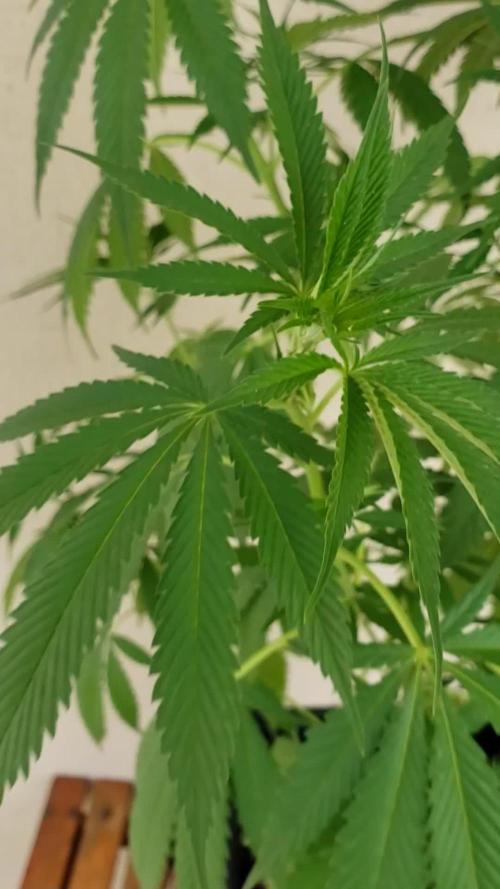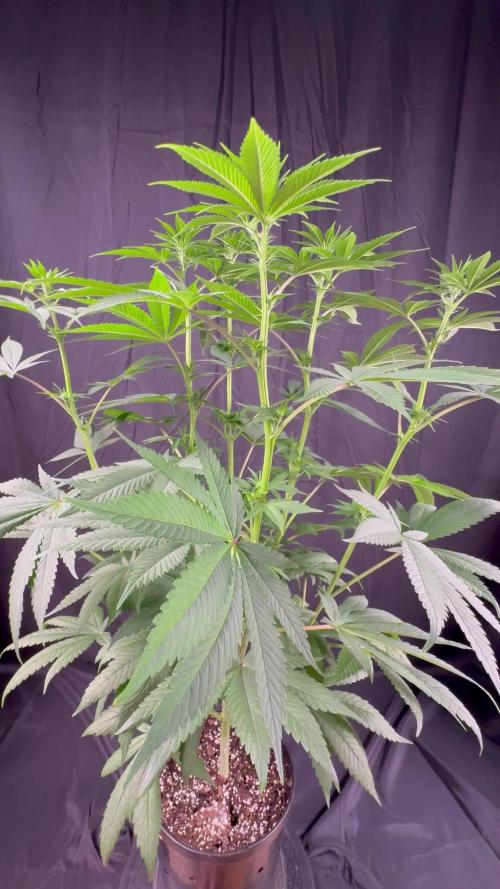The Grow Awards 2026 🏆 





























Likes
Comments
Share


@CANNASIM
Follow
We are at week 3 now. A lot of development, i have not used liquid nutes this week, it is raining a lot so no water needed, thus no liquid nutrients.
I have top feed of dry nutrients mix, basically a mixture of a super soil recipe that usually is used within to make a hot soil:
I mix all tue ingredients together and use it gradually about 40g as a powder, in the top of the soil.
- Azomite 500g
- Natural fosfate 500g
- Biochar 1kg
- Bokashi 1kg
-Kelp meal 500g
-Mamona meal 1kg
-chicken meal 1kg
-Potassium silicate 500g
-Gypsum farm 500g
-Diatomaceous earth 500g
Mix all keep it in a soil bag, this pure mix and use it once every month.
The companion plants have emerged and will protect the soil humidity mainly.
Likes
30
Share


@Grower_Of_Persia
Follow
week intel:
we are going through slowly
stresses :
just a little E.C stress around 1.4 once a week
feeding:
i feed them 3 times this week with this order :
day 1 : i feed them heavy with silicate +base nutrients(calcium & micros + Bloom) about 700 ppm - 1.4 e.c to cause a little stress.
day 3 : i feed them low dose of Feeding Booster around 327 ppm - 0.64 e.c to let them recover a little but not fully recover still a little stress will caused.
day 5 : i feed them with low dose of Top-Max + B-52 around 255 ppm - 0.5 e.c to let them recover the stresses to get ready for another stress next week.
guide of the week :
know your plant tolerance limit of E.C stress once you saw the very very little yellowing on tips of leaves , that's the sign to don't go further , never reach that limit if you want a high quality buds, in my case tolerance is 1.4 and i'll reach to that level only once a week to cause precision stress , love your plants and have a happy growing!
Likes
10
Share


@Mo_Powers
Follow
actually she is doing quite well. the buds look good. unfortunately she got mildew. i tried to remove everything as good as possible. unfortunately not 100% possible on the outside. i hope she makes it until the harvest. pictures will follow.
Likes
6
Share


@Mr_nugs_lover_David
Follow
Such a top quality strain 🔝 very very terpy, stinks like OG kush, rock hard dense nuggets, they're literally rocks. Very frosty nuggets, full covered in resin flowers. Those orange hairs just make her irresistibly delicious 😋 I just can't wait to smoke such a high grade. This is gonna be a good year. Hope to always have this lady in my garden every year 🤤👨🌾💎🍪
Likes
24
Share


@ganzigunnu
Follow
having hard time reducing the humidity. everything else is going well.
Likes
8
Share


@Kindbudz
Follow
This week has gone great! At the beginning of the week we flushed the remaining Fox farm nutrients we had been using before with Sledgehammer. After we treated with an organic compost tea brewed by our local hydroponic shop. We started with the Cyco Platinum Series this week. It’s still a bit early to tell but we will see how this nutrient line performs. I am very optimistic. As you may be able to tell I have a reservoir with coco coir mix on top with a drip irrigation system. I’m going to be trying out this system and an ebb and flow system in the upcoming weeks. I’m looking to maximize quality and quantity and believe these two system offer some of the best results. We look forward to starting that project! As for the lady she is looking extremely healthy. She is recovering well from being topped and lst. We’re going to let her grow up a bit now and stretch her out across the first trellis. My experience says this should be in 2-3 weeks and the. We will let her grow up through the second trellis. All in all I believe I’m looking at a 7-10 week veg. My goal is to shoot for a minimum of 1.3lbs from one plant. Thanks for taking the time to read this. Leave a comment if you have any questions or if you have any suggestions! Please check out my Instagram. Link in my Bio. Peace ✌️ Love ❤️ and Thanx 👍
Likes
11
Share


@StrontiumGrow420
Follow
Pre-harvest flush week.
Managed to take some macro images of the lovely sweet resin seeping from the dark devil autos.
Processing
Likes
12
Share


@PacoMendoza420
Follow
Pretty solid start for this week, all the plants took just one day to recover from the last session of training and they are showing new vigorous growth already.
1st day fed them with my usual secret mix of organic good stuff
Day 32, 4th day of week 5. Babies recover at max speed so I can continue to top and train
them to achieve the wanted structure. They already show signs of flowering hormones telling me that when I want to flip, they are ready.
Day 35, last defoliation of the week and I think also I will do just another defoliation right before flippin to flower
Likes
35
Share


@Kellykush420
Follow
This week I found fungus gnats I added sticky boards and mosquito bits. A small amount of fading on oldest leaves. I did a small defoliation of the yellow fan leaves. I added bone meal to the top layer of soil and worked it in. Water at 6.5.
Processing
Likes
51
Share


@Silverback_Guerilla
Follow
11/1:
I started a pair of each of the Wicked Stix beans, but had a couple of failures and ended up planting a Berry Bomb and a GG4 as replacements.
Sucrose Overdose (aka "Sugah") seeds are derived from a legendary InHouse Sugar Cane plant. They are F2's, selfed from possibly the frostiest cannabis plant on earth..so I'm pretty anxious to see how they, and her hybrids, do in my garden.
Muscadine Wine seeds are derived from a strategic cross between a delicious InHouse Black Cherry Punch and the aforementioned, legendary Sugar Cane plant.
Platonium seeds are derived from a strategic cross between a really gnarly InHouse Platinum Jelly and the aforementioned, legendary Sugar Cane plant.
Sucrose Breath / aka "Sugah Bref" seeds are derived from a strategic cross between a spectacular InHouse Velvet Breath and the aforementioned, legendary Sugar Cane plant.
SPECIAL THANKS go to Wicked_Stix for this incredible opportunity to grow real 🔥FIYAH🔥 🙌!!!
11/3:
Seeing sudden signs of an N deficiency on a Sucrose Overdose and a few other seedlings in the garden. Fed them for the first time and started foliar feeding with Microlife Super seaweed.
Likes
8
Share


@SpaceGorilla_01
Follow
Them issues with the haze xl really upset me wate of tome effort and money so im not impressed with 1st impressions of sweetseeds im sorry but we have to be honest im this community would you not agree but on the plus all my fastbuds 100% success
Likes
Comments
Share


@The_Doctor_Green
Follow
Hola a todos!!!
A esta laughing buda no la he atendido muy bien esta semana, noto cuando llega la noche que se engarran las hojas, para mi necesita una maceta más grande., esta semana la pasare a otra maceta.
He regado con agua y shanty 1ml x litro de agua.
Processing
Likes
7
Share


@Clepage4
Follow
Hopefully only two more weeks to let her flower. Keeping an eye out for the color change. Everything seems to be bulking up as we speak.
Likes
5
Share


@Ninjabuds
Follow
El dorado og has some old school genetics to is and they are starting to shine. It’s really starting to stack up the stems real nicely. The plant reaks like skunk. I bet it turns out really nice
All of the plants have really taken off. Usually I have a couple plants that are much smaller but all of these plants are getting huge. Seeing I got a new eluefah uap1500 the other day and I have my 2 fastbuds plants under that now I have my spider farmer light free. So I popped up another 2x2 and moved 3 of the 10 plants into the 2x2 and left the 7 other in the 2x4.
Likes
8
Share


@AtticGrowing
Follow
This girl did amazing, even after being blasted by a space heater. Strong secondary branching, big colas producer, nice trichomes coverage and good bud density.


























